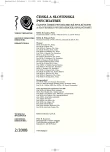Results of a Detailed Observation Concerning Application of Coercive Measures during Hospitalization – the EUNOMIA Project, Results in the Czech Republic
Authors:
doc. MUDr. Lucie Kališová, Ph.D. 1; J. Raboch 1; L. Číhal 1; E. Kitzlerová 1; Skupina Eunomia 1,2
Authors‘ workplace:
Psychiatrická klinika 1. LF UK a VFN, Praha
; přednosta prof. MUDr. J. Raboch, DrSc.
Psychiatrická léčebna Bohnice, Praha
1; ředitel MUDr. I. David, CSc.
2
Published in:
Čes. a slov. Psychiat., 104, 2008, No. 2, pp. 52-58.
Category:
Original Article
Overview
The application of coercive measures to mentally ill people is a very sensitive topic. The type and frequency of this action is influenced by different cultural or legal traditions, general attitudes toward mentally ill people and the structure and quality of mental health care system. The aim of this article is to present national results of the EUNOMIA international project which focused on detailed monitoring of the use of coercive measures in the group of involuntarily admitted patiens.
Key words:
coercive measures, restraint, seclusion, involuntary medication.
Sources
1. Allen, M. H.: Managing the agitated psychotic patient: A reappraisal of the evidence. J. Clin. Psychiatry, 61, 2000, 61 (Suppl 14), pp. 11-20.
2. Baudiš, P., Kališová, L., Kitzlerová, E., Petr, T., Miklóš, T.: Omezovací prostředky. In. Raboch a spol.: Psychiatrie. Doporučené postupy psychiatrické péče II. Infopharm, 2007, s. 152-163.
3. Beer, M., Pereira, S, Paton, C.: Intenzivní péče v psychiatrii. Praha, Grada, 2004, 296 s.
4. Carpenter, M. D., Hannon, V. R., McCleery, G. et al.: Variations in seclusion and restraints practices by hospital location. Hosp Community Psychiatry, 39, 1988, pp. 418-423.
5. Currier, G. W, Chou, J. C. Y, Fejfek, D. et al.: Acute treatment of psychotic agitation: a randomized comparison of oral treatment with risperidone and lorazepam versus intramuscular treatment with haloperidol and lorazepam. J. Clin. Psychiatry, 65, 2004, pp. 386-394.
6. Fischer, W. A.: Restraint and seclusion: A review of the literature. Am. J. Psychiatry, 151, 1994, pp. 1584-1591.
7. Greenberg, W. M., Moore-Duncan, L., Herčin, R.: Patients´attitudes towards having been forcibly medicated. Bull. Am. Acad. Law Psychiatry, 24, 1996, pp. 513-524.
8. Hoge, S. K., Appelbaum, P. S., Lawlor, T. et al.: A prospective multi - center study of patients´refusal of antipsychotic medication. Arch. Gen. Psychiatry, 47, 1990, pp. 949-956.
9. Hoyer, G., Kjellin, L., Engberg, M. et al.: Paternalism and autonomy: a presentation of a Nordic study on the use of coercive measures inthe mental health care system. Int. J. Law Psychiatry, 25, 2002, pp. 93-108.
10. Jonikas, J. A., Cook, J. A., Rosen, CH. et al.: A program to reduce use of physical restraint in psychiatric inpatient facilities. Psych. Services, 55, 2004, pp. 818-820.
11. Kališová, L., Raboch, J., Kitzlerová, E., Novotná, I.: Obecná praxe užívání omezovacích opatření – monitorování situace v České republice. Čes a slov Psychiatr, 101, 2005, 6, s. 303-307.
12. Kališová, L., Raboch J., skupina EUNOMIA: Psychofarmaka podávaná při akutním neklidu – mezinárodní srovnání, projekt EUNOMIA. Psychiatrie, 12, 2008; (Suppl. 1), s. 39.
13. Kališová, L., Raboch, J., Novotná, I., Černý, M., Victorínová, K., Kitzlerová, E., Nawka, A., Chudárek, F.: Užití omezovacích opatření a prostředků v psychiatrii – mezinárodní projekt EUNOMIA. Čes a slov Psychiat, 2004, 7, s. 420-427.
14. Kallert, T. W., Glöckner, M., Onchev, G., Raboch, J., Karastergiou, A., Salomon, Z., Magliano, L., Dembinskas, A., Kiejna, A., Nawka, P., Torres-Gonzáles, F., Priebe, S., Kjellin, L.: The EUNOMIA project on coercion in psychiatry: study design and preliminary data. World Psychiatry, 4, 2005, 3, pp. 168-172.
15. Kaltiala-Heino, R., Valimaki, M., Korkeila, J. et al.: Involuntary medication in psychiatric inpatient treatment. European Psychiatry, 18, 2003, pp. 290-295.
16. Kasper, J. A., Hoge, S. K., Feucht-Haviar, T. et al.: Prospective study of patients´refusal of antipsychotic medication under a physician discretion review of procedure. Am. J. Psychiatry, 54, 1997, pp. 483-489.
17. Khadivi, A. N., Patel, R. C., Atkinson, A. R., Levine, J. M.: Association between seclusion and patient-related violence. Psych. Services, 55, 2004, pp. 1311-1312.
18. Korkeila, J. A., Tuohimaki, C., Kaltiala-Heino, R. et al.: Predicting use of coercive measures in Finland. Nord J. Psychiatry, 56, 2002, 5, pp. 339-345.
19. Metodické opatření Ministerstva zdravotnictví ČR k používání omezovacích prostředků u pacientů v psychiatrických zařízeních České republiky. Věstník MZ č. 1/2005.
20. Overall, J. E., Gorham, D. R.: Brief psychiatric rating scale. In: Guy, W. (Ed.): ECDEU assessment manual for psychopharmacology. Rev. Ed. Rockville, Maryland, 1976, pp. 157-169.
21. Petr, T.: Restriktivní metody v psychiatrii – zkušenosti z PL Bohnice. Sestra, 2004, 9, s. 10-11.
22. Petr, T., Miklóš, T.: Restriktivní metody v psychiatrii. Standardizace ošetřovatelské péče. Psychiatrická léčebna Bohnice, Praha, 2004, 40 s.
23. Doskočilová, K.: Ochranné omezovací prostředky v psychiatrických léčebnách. Sestra, 2004, 9, s. 12-13.
24. Raboch, J., Kališová, L., Kallert, T.: Comparison of the clinical use of individual coercive measures during hospitalisation across the EUNOMIA study sites. WPA thematic conference: Coercive Treatment in Psychiatry, June 2008, Dresden, Germany. Abstract book, p. 53.
25. Ray, N. K,, Rappaport, M. E.: Use of restraint and seclusion in psychiatric settings in New York state. Psychiatr. Serv., 46, 1995, pp. 1032-1037.
26. Sailas, E., Fenton, M:. Seclusion and restraint for people with serious mental illnesses. Cochrane Database Syst. Rev., 2000, 2,CD001163.
27. Yesavage, J. A.: Correlates of dangerous behaviour by schizophrenics in hospital. J. Psychiatr. Res., 18. 1984, pp. 225-231.
28. Zákon 240/1993 Sb. (Občanský soudní řád).
29. Zákon o péči o zdraví lidu č. 20/1966 v platném znění (zákon ČNR 86/1992 Sb.)
Labels
Addictology Paediatric psychiatry PsychiatryArticle was published in
Czech and Slovak Psychiatry

2008 Issue 2
Most read in this issue
- Risperdal Consta – Long-term Acting Injections in the Treatment of Schizophrenia and Schizoaffective Disorders: Preliminary 12-Month Results of the Project e-STAR in the Czech and Slovak Republics
- Results of a Detailed Observation Concerning Application of Coercive Measures during Hospitalization – the EUNOMIA Project, Results in the Czech Republic
